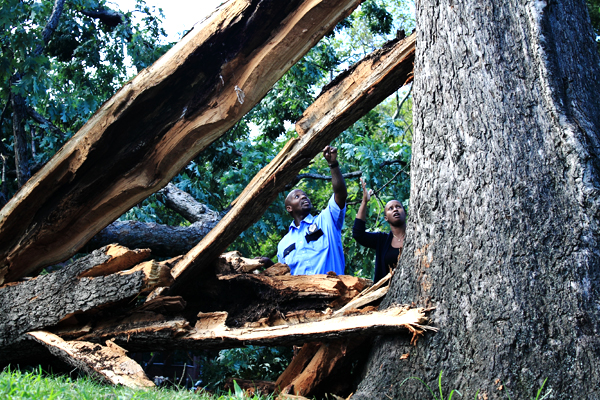
Photo by: Adi Talwar
Damage from Hurricane Irene in the Bronx. Very few new trees were affected by the storm, but older trees suffered and caused damaged.
In an audit released over the weekend, Comptroller Scott Stringer exposed a number of problems in the city’s tree pruning program—mainly in how well the city keeps lists of trees needing work and tracks the performance of contractors hired to service the trees.
City Limits first wrote about this issue in early 2012, right after a summer and autumn that was incredibly tough on city trees. First there was Hurricane Irene. Then came that freak October snowstorm hit when trees that still had plenty of leaves stretching out to capture all that heavy, slushy snow.
Part of the story, of course, was that the Bloomberg administration was—admirably—adding tens of thousands of trees to the city’s land without building into the Parks Department budget enough money to maintain all that lovely lumber.
But some of it had as much to do with aging trees that had long been part of the city’s green portfolio. In particular, authors Paul Bufano and An Phung singled out the risks of the London Plane tree:
“The London plane tree is just about everything you want in an urban tree: it strongly resists harm from pests, pollution and urban conditions.
The problem with London planes is that they are getting old. Trees continue to grow as they age, and older trees are more difficult to prune. Even worse, London planes create expansive canopies, so their long branches have a greater tendency to shear off in storms. In the October snowstorm, this was evident particularly in Central Park, as huge limbs shattered on the ground from the weight of the heavy snow.
“The danger with so many London Planes having been planted during the Moses era was that it created a monoculture,” says [then Parks’ Director of MillionTreesNYC Morgan] Monaco. “A single invasive species could take out many trees at once.”
The city now undertakes a meticulous process for determining which mix of trees is most appropriate for the city.
But even as new trees are added, London planes are still the most common tree in the city, and will continue to pose problems as they continue to get older.”
Statistics from the city’s Mayor’s Management Report suggest an upswing in pruning over the past few years. From fiscal 2012 to fiscal 2013, which ended in July 2013, the number of trees pruned jumped 58 percent. And based on the first four months of fiscal 2014, which ended in July, pruning was on pace to jump another 69 percent, which would take it up to the level the city enjoyed when federal stimulus funds were rolling in.
The city planted more than 110,000 trees in fiscal 2013 and was on pace to exceed that in the fiscal year that ended this July, though final numbers aren’t in yet.
Lost in all the discussion about planting and pruning is that some trees just don’t make it. The number of trees removed has been steadily climbing.
Chart source: Mayor’s Management Report







